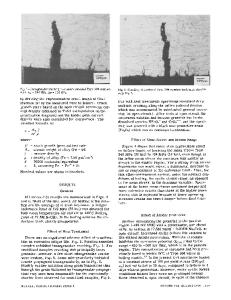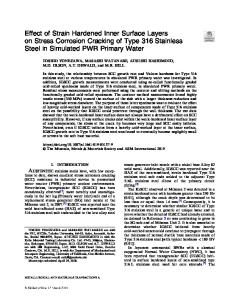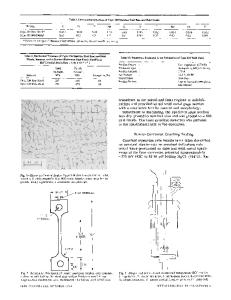Intergranular stress corrosion cracking behavior of types 308 and 316 stainless steel weld metals in a simulated boiling
- PDF / 17,719,080 Bytes
- 13 Pages / 612 x 792 pts (letter) Page_size
- 86 Downloads / 330 Views
N
THE inside surfaces of pressure vessels, which are fabricated from low-alloy steels, for boiling water reactors (BWRs) are clad with stainless steel or high nickel alloy weld metals; these surfaces contact the high-temperature reactor water. The stainless steel weld metal is usually type 308, which has a two-phase microstructure consisting of a small amount of ferrite (␣ ) in a matrix of austenite (␥ ). This particular microstructure prevents hot cracking during welding. The amount of ferrite is controlled mainly by the chemical composition of electrodes or filler metals, depending on the welding method employed. During the fabrication of a pressure vessel, the overlaid weld metals are subjected to a postweld heat treatment (PWHT) at about 600 ⬚C for relieving residual stress of heavy section welds. The time of the PWHT varies section by section, depending on each welding schedule; and it varies from several hours to about 40 hours. As a result, PWHT produces various metallurgical conditions in the weld metals, including sensitization, which is the main cause of intergranular corrosion (IGC) or intergranular stress corrosion cracking (IGSCC). Also, it is claimed that operation at 288 ⬚C may cause further sensitization during long periods of service[1] (low-temperature sensitization (LTS)). Thus, the corrosion resistance of the overlay weld metal has to be evaluated under various heat-treated conditions, including the LTS effect. The sensitization behavior of type 308 weld metals has
been studied extensively.[2–7] One of the common conclusions is that type 308 weld metal becomes susceptible to IGC by relatively short PWHT but is healed (or thermally stabilized) by longer PWHT. However, the LTS after PWHT has not yet been examined. For this particular behavior of two-phase stainless steel weld metals, the present authors recently proposed a mechanism by which the sensitization and healing, as well as the LTS, can be explained by a single process considering the carbon partitioning between ␣ and ␥ phases.[8] On the other hand, a cast grade of type 316 stainless steel, having the same two-phase microstructure as described earlier, has been shown to resist IGC and IGSCC even in heavily sensitized conditions.[9] This fact suggests that type 316 stainless steel could be applied as a good overlay weld metal for rector pressure vessels or attached nozzles, which also have to be internally clad. This article describes the sensitization behavior of types 308 and 316 stainless steel weld metals by shielded metal arc welding (SMAW) in various heat-treated conditions. Special attention was paid to the effects of carbon and ferrite contents under PWHT ⫹ LTS. The applicability of type 316 stainless steel weld metal was shown not only from the corrosion standpoint of view, but also on the embrittlement due to PWHT. In this work, corrosion resistance was determined by measuring the rate of IGC, which could be correlated with IGSCC in high-temperature oxygenated pure water. II. EXPERIMENTAL PROCEDURE A. Test Material
IKUHISA HAMAD
Data Loading...











